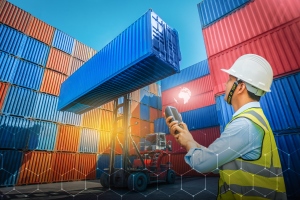Shelves sit empty, customers rush into stores to panic-buy and order fulfilment slows to a halt while these scenarios may seem familiar from the early stages of the pandemic, businesses face a similar supply chain crisis now.
The crisis is affecting nearly every sector, from construction to energy, and even McDonalds milkshakes, says Marcus Jeffery territory manager UK & Ireland, Ivanti Wavelink. For businesses attempting to keep up with growing customer demands, the labour shortage and the supply chain disruption it is causing seem to be insurmountable problems to solve. Businesses are scrambling to onboard a human workforce to reduce the impact, but the crisis isn’t expected to end anytime soon. Indeed, the CBI predicts that this crisis will last at least for the next two years.
Implementing Industrial IoT (IIoT) technologies can serve as the solution businesses need. IIoT can offer the automation framework and data collection to better understand productivity within the supply chain. Businesses can therefore optimise their supply chain to mitigate the labour shortage in the short term and meet customer demands in the long term.
What IIoT solutions bring to the table
To reduce the strain on their supply chains, businesses should lean on and invest in technology. The Industrial (IoT) IIoT helps to secure the supply chain of the future and further enable Industry 4.0. An IIoT platform provides increased visibility both at macro and micro levels and connects and protects the end-to-end supply chain process. It allows businesses to improve accuracy, productivity, safety and drive decisions with data accuracy.
For instance, businesses can install geolocation beacons on trailers and shipping containers to gain a better understanding of the ETA of items arriving in and departing from the warehouse. That way, warehouse managers can better prioritise certain loads and items that need to be loaded or offloaded onto the trailers depending on their estimated arrival time.
IIoT solutions democratise information within all levels of an organisation. They give businesses a 360-degree view of their IIoT equipment to proactively identify and resolve any issues in real-time to drive operational efficiency. It ensures businesses have the resources they need, when they need them and that all pieces of equipment are running to the best of their ability. It also notifies companies of any exceptions that may impact their ability to continue business as usual.
The use cases of IIoT are limitless. Accessibility to information allows organisations to improve and build from the ground-up, whether by allowing a business to track products from supplier to supplier, offer insight into risks outside of the enterprise, plan contingencies based on this insight and adjust their workforce resources accordingly.
Narrowing the labour shortage gap
Labour shortages have jumped to 54%, hitting retail and manufacturing sectors the hardest. As a result, not only are global economies expecting to see food shortages by Christmas, but prices of goods are skyrocketing. No sector has been left untouched, and all are left unsatisfied from employees to customers to businesses.
While organisations are attempting to counter these effects, by offering bonuses to attract recruits, ultimately these initiatives won’t keep the supply chain running smoothly. To protect themselves long-term, businesses need to rethink and restructure their foundations, rather than implement a top-down solution.
An IIoT platform offers the visibility businesses need to understand their existing supply chain, discern how to improve it, and optimise these processes for success even in the face of a labour shortage. Through an IIoT solution, organisations can remove humans from the decision-making process and instead replace them with automation to ensure the business is using a limited but crucial asset, its people, in the best and most effective way possible.
For organisations plagued with a labour shortage, IIoT can help by providing logistics management, asset tracking, predictive repairing, and remote production control meaning businesses can be less dependent on employees for physical labour, such as order fulfilment.
The roadmap to effectively integrating IIoT
IIoT technology is a growing market, valued at $128.9 billion (€111.20 billion), and it is expected that it will expand further by 26.7%. While businesses are eager to implement IIoT technology to optimise their supply chains, many have struggled in this pursuit.
While one of the benefits of the IIoT is its breadth and possibility, if organisations fail to integrate this technology without a clear plan in mind, they risk investing in innovation that doesn’t provide the visibility they so seek.
Some businesses see IIoT as a point solution an additional tool to be added to an increasing array of disjointed and unconnected technologies. However, in doing so, they fail to take advantage of IIoT’s scope. Organisations looking to mature would do best to develop a flexible strategy and discern how IIoT can mature with them, rather than focusing exclusively on the short-term gains.
To ensure success, then, companies need to define what they wish to achieve. Instead of putting the cart before the horse, organisations should let their business strategies and goals guide them and their implementation of IIoT technology. For IIoT to be an effective solution to the supply chain crisis, then, businesses must look at their workforces and think about how they can deploy IIoT metrics to drive the predictive supply chain. That analysis will empower businesses to ensure their workforces are always at peak productivity and fill the labour shortage gap through innovation.
What’s next?

Looking beyond the pandemic and saving this year’s holiday season, IIoT technology can revolutionise the supply chain industry, by giving agency and control back to businesses.
Going forward, IIoT will look more like IIoB Industrial Internet of Behaviours. While businesses work on optimising their warehouses, the next goal will be how to use data to enhance workforce behaviour, as it relates to productivity, safety, and accuracy. Data can provide visibility into every and any facet of the workforce, meaning that businesses can better understand employee behaviour and subsequently improve the workplace.
While supply chains struggle from labour shortages, IIoT can help businesses ensure that the employees they do have are as productive as possible to meet current and future consumer demands.
The author is Marcus Jeffery, territory manager UK & Ireland, Ivanti Wavelink.
Comment on this article below or via Twitter: @IoTNow_OR @jcIoTnow










